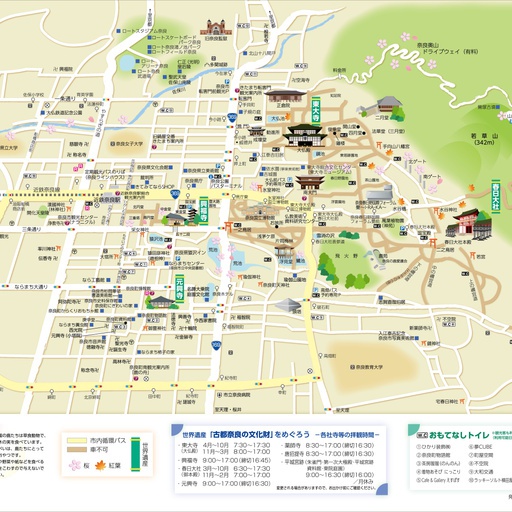奈良公園ウォークマップ

世界遺産「古都奈良の文化財」を巡ろう 奈良公園は、歴史と自然が調和する日本有数の観光名所です。広大な敷地には奈良時代の文化遺産である多くの寺院や史跡が点在し、特に鹿との共存が有名です。奈良時代に始まる歴史的建造物や仏像、美しい庭園などが訪れる人々を魅了します。また、四季折々の美しい自然も楽しめ、春には桜、秋には紅葉が見事な風景を演出します。奈良公園内の散策路を歩きながら、古都ならではの風情を感じてみてください。 *奈良公園の鹿たちは草食動物で芝や木の実を食べています。鹿せんべいは、鹿たちにとって安全なおやつです。お菓子や野菜や紙などを食べるとお腹をこわすので与えないでください。
 Posted byまちづくりプラットフォーム更新日:
Posted byまちづくりプラットフォーム更新日: すべてのスポット情報
44件のスポット
 博物館・美術館・資料館
博物館・美術館・資料館
奈良町からくりおもちゃ館
![]() 博物館・美術館・資料館
博物館・美術館・資料館

伝統的な奈良町の町家の中で昔ながら「からくりおもちゃ」が多数展示されています。触れて遊んでも大丈夫!「からくりおもちゃ製作体験講座」も毎月開催されています。 住所 〒630-8338 奈良市陰陽町7番地 --> 公式サイト Official Site

長い歴史の中で研ぎ澄まされてきた奈良工芸の振興発展を図るため、奈良工芸品並びにその製作道具、材料の収集及び展示や奈良工芸に関する情報の発信等を行っています。 住所 奈良市阿字万字町1番地の1 --> 公式サイト Official Site
奈良市杉岡華邨書道美術館
![]() 博物館・美術館・資料館
博物館・美術館・資料館

奈良市在住の書家で、文化勲章受章者杉岡華邨氏より作品の寄付を受け建設された書道の美術館です。美しいかな書の作品を展示しています。 書家 杉岡華邨 かな書の第一人者、1913年下北山村生まれ。 「美術館がにぎわえば、書道文化の振興と発展につながるものと喜んでいます。今後はライフワークとして取り組んでいる紫式部の源氏物語に出てくる書について講座等で話したい。」 住所 〒630-8337 奈良市脇戸町3番地 --> 公式サイト Official Site

市内の旧蔵文書類、明治時代の新聞など、主として近世・近代の貴重な史料を多数保存しています。また、奈良奉行所復元模型など、所蔵史料の一部を展示しています。 住所 〒630-8337 奈良県奈良市脇戸町 -->

仏教彫刻、仏教絵画など仏教美術の名品が多数展示されており、なら仏像館では100体近くの仏像を常時展示しています。新館では年3回ほど特別展を開催しています。 住所 630-8213奈良市登大路町50 --> 公式サイト Official Site
入江泰吉記念 奈良市写真美術館
![]() 博物館・美術館・資料館
博物館・美術館・資料館

約半世紀にわたり、奈良の風景や仏像を撮り続けた故入江泰吉氏が、全作品を奈良市に寄贈されたのを機に建築家・黒川紀章氏の設計で建設しました。入江氏の作品展示を中心に、他の写真家の作品も企画展として行います。ハイビジョンでも作品を鑑賞出来ます。 住所 〒630-8301 奈良市高畑町600-1 --> 公式サイト Official Site
 観光施設
観光施設
 建築物
建築物

この案内所の建物は、昭和15年に南都銀行手貝支店として建築されました。近代建築家である岩崎平太郎氏により設計され、町家の形態を遺した近代建築として貴重なものです。 案内所では、平成24年7月に開所した「旧鍋屋交番きたまち案内所」と連携しながら、東大寺転害門や正倉院などの世界遺産、歴史的な町並みに加え、きたまち地域の近代遺産など、きたまちの魅力を発信します。 住所 奈良市手貝町54番地の1 -->
奈良市総合観光案内所
![]() 建築物
建築物

JR奈良駅旧駅舎は平成21年7月25日、奈良市総合観光案内所としてオープンしました。外国語観光案内、インターネットに接続した観光情報検索コーナーもあります。 住所 奈良市三条本町1082番地 -->

奈良公園・鷺池に浮かぶ檜皮葺き(ひわだぶき)、八角堂形式(六角形)のお堂です。水面に写る姿が美しく、水辺の憩いの場となっています。現在の浮見堂は、旧浮見堂が老朽化したために、平成3年から平成6年にかけての3年間の修復工事によって、その美しさを今によみがえらせました。 春日大社より浅茅が原の林をぬけて行くとつきあたります。 住所 -->

奈良町の伝統的な町家を再現しており、外だけでなく中からもじっくりと見ていただけます。昔の奈良の町家の生活様式に直接ふれていただくとともに、奈良町の情報提供の場、観光客や市民の憩いの場としても自由にご利用いただけます。 住所 〒630-8332 奈良市元興寺町44 --> 公式サイト Official Site
 古墳・陵墓
古墳・陵墓
 寺
寺

十輪院は元正天皇の勅願寺にして元興寺の元子院です。本堂(国宝)内に祀られた石仏龕(重文)は、その内部に、地蔵菩薩立像、釈迦如来立像、弥勒菩薩立像などを浮彫りした珍しいものです。 住所 〒630-8312 奈良市十輪院町27 --> 公式サイト Official Site

もともとは興福寺の別院で興北院と呼ばれていました。称名寺という名称は、文永2年(1265)興福寺の僧、專英と琳英、京都西山三鈷寺の澄忍上人の三僧が、念仏の道場として開した時に始まります。 茶道の始祖とうたわれ、同寺の僧でもあった村田珠光は「独盧庵」(俗称 珠光庵)を建て“陀び茶”の境地を開いたといわれ、珠光ゆかりの寺として今も多くの人が訪れています。 ※本堂・茶室は、5/15特別公開のみ拝観できます。 住所 〒630-8254 奈良市菖蒲池町7 -->

伝香寺は天平宝亀年間に鑑真和上の弟子、思託律師によって開かれたといわれています。境内にある椿は奈良三名椿の一つで、花びらが一枚づつ散ってゆくところから散り椿と呼ばれています。 住所 〒630-8233 奈良市小川町24 --> 公式サイト Official Site

新薬師寺は、天平19年(747)に、聖武天皇の病気平癒を祈って光明皇后により創建され、7体の薬師如来像が安置されたと言われています。かつては七堂伽藍が整った壮大な寺院で、創建当初の建造物として本堂(国宝)が今に残ります。東門・南門・鐘楼・地蔵堂はいずれも鎌倉時代に建立され、重要文化財に指定されています。本堂内には円形の土壇が築かれ、壇上には本尊薬師如来坐像(木造・国宝)と、それを囲む日本で最古最大の十二神将立像(塑像・国宝)が安置されています。 住所 〒630-8301 奈良市高畑1352番地 --> 公式サイト Official Site

高円山(たかまどやま)西麓の高台に位置し、境内からは奈良市街を一望。草創については諸説あり、天智天皇の子、志貴皇子(しきのみこ)の山荘跡に建てられたという言い伝えも。鎌倉時代には多くの寺を復興した興正菩薩叡尊により、再興されたと伝わっています。叡尊の弟子・道照が中国から宋版一切経(いっさいきょう)の刷本(すりほん)を持ち帰ってからは「一切経寺」とも呼ばれ、本尊阿弥陀如来坐像や閻魔王坐像など重要文化財の仏像8体を宝蔵に収めています。境内には県天然記念物の五色椿の古木があり、奈良三名椿の1つとして有名。また、秋には参道の石段を見事な萩の花が彩ります。 (写真提供=白毫寺) 住所 〒630-8302 奈良市白毫寺町392 -->

寺伝によると629年高句麗の僧慧灌がこの地に寺を建てたのが始まり。その後天平7年(735)聖武天皇の時、平城京の鬼門鎮護のため堂塔を造営されたと伝えられています。京都から奈良への要路にあたるため、治承の兵火で戦火をこうむりましたが、西大寺の叡尊上人により文殊の霊場として復興され、庶民救済の文殊会を盛んに開くようになりました。鎌倉期の優美な建築様式をもつ楼門〔国宝〕が残っています。楼門の奥正面に立つ十三重石塔〔重文〕は、高さ約14.2メートル。石仏を彩って咲く春の山吹、秋のコスモスなどが美しく、花の寺としても有名です。 住所 〒630-8102 奈良市般若寺町221 --> 公式サイト Official Site
 自然・景勝地
自然・景勝地

年に1度の「若草山焼き行事」でも有名な若草山。3つの笠を重ねたように見えるため「三笠山」とも呼ばれています。 山麓のゲート(南北)から入山し、一重目、二重目、山頂(三重目)、鶯塚古墳周辺道など、それぞれ異なる景観を楽しめます。山麓ゲートから山頂までは徒歩約30分~40分。若草山山頂からは、東大寺、興福寺など、奈良の景観を眺めることができます。開山期間は、3月第3土曜日~12月第2日曜日。9:00~17:00まで。 また「奈良奥山ドライブウェイ」を通り、車で山頂(三重目)へアクセスできます。山頂から眺める夕日や夜景(新日本三大夜景)は圧巻です。 住所 奈良市雑司町469 --> 公式サイト Official Site
 神社
神社

奈良市最古の神社。御子神様であるご祭神・媛踏鏑五十鈴姫命(ひめたたらいすずひめのみこと)をお守りするように、向かって左に父神・狭丼大神 (さいのおおかみ)、右に母神・玉櫛姫命(たまくしひめのみこと)をおまつりしていることから、古くより「子守明神」と親しまれ、安産、生育安全、家庭円満の神として信仰を集めている神社です。毎年6月17日には別名「ゆりまつり」でも知られる例祭「三枝祭」(さいくさのまつり)が執り行われます。 (写真提供=率川神社) 住所 〒630-8231 奈良市本子守町18 -->

漢国神社は、推古天皇の元年(593)、勅命により大神君白堤(おおみわのきみしらつつみ)が大物主命を、その後、養老元年(717)には藤原不比等が大己貴命と少彦名命(すくなひこなのみこと)を合祀されました。古くは春日率川坂岡社と称していました。境内には、室町時代のはじめ中国から渡来し、日本に初めて饅頭を伝えた林浄因(りんじょういん)を祀る林神社があります。 住所 奈良県奈良市漢国町 -->

猿沢池のほとりにある、春日大社の末社。『大和物語』によると、奈良時代に天皇の寵愛が薄れたことを嘆き、猿沢池に身を投じた采女(うねめ。身の回りの世話をする女官)の霊を慰めるために創建されました。毎年中秋の名月には、采女の霊を鎮め同時に人々の幸せを祈る例祭「采女祭(うねめまつり)」が執り行われます。 (写真提供=春日大社) 住所 〒630-8218 奈良県奈良市樽井町 -->

紅葉の名所、手向山の山麓にあり天平勝宝元年(749)東大寺大仏建立のため、九州豊前国(大分県)宇佐八幡宮より東大寺守譲の神としてむかえ、まつられました。 住所 〒630-8211 奈良県奈良市雑司町434 -->
 世界遺産
世界遺産

春日山は春日大社の神山として1000年以上も伐採が禁じられていたため、カシ、シイ類を主体とした常緑広葉樹林の原始林となっています。昼なお暗い山内には、モリアオガエル、ヒメハルゼミ、カスミサンショウウオなど珍しい動物が生息しています。昭和30年に特別天然記念物に指定され、また平成10年(1998)世界遺産に登録されました。 住所 奈良市春日野町 -->

奈良時代の初め、平城京鎮護のために茨城県鹿島の武甕槌命(たけみかづちのみこと)を御蓋山(みかさやま)の山頂に祀ったのが起こりとされています。神護景雲(じんごけいうん)2年(768年)、称徳天皇の勅命により現在の場所に社殿を造営し、千葉県香取から経津主命(ふつぬしのみこと)、大阪府枚岡から天児屋根命(あめのこやねのみこと)、比売神(ひめがみ)をあわせて祀りました。 平安時代になると皇族や貴族の春日詣も盛んになり、20年ごとの式年造替の確立に伴い、本殿以下各社殿は現在のような規模になりました。また中世以降になると武家や庶民にも信仰が広まり、全国各地に3,000社を超える分社が造られるまでになりました。 境内には「万燈籠」で知られるさまざまな形の釣燈籠、石燈籠があり、それらの多くは庶民の寄進によるものだということからも、庶民信仰の深さを伺い知ることができます。毎年2月節分の日と8月14・15日にすべての燈籠に火を入れる「万燈籠」の神事が行なわれ、その幻想的な美しさに、多くの参拝客が訪れます。 (写真提供=春日大社) 住所 〒630-8212 奈良市春日野町160 --> 公式サイト Official Site

南都七大寺の中で最も密接に奈良の街とつながりを持ちながら発展した寺。和銅3年(710)藤原不比等が飛鳥から平城京へ前身の厩坂寺を移転したもので、藤原氏の氏寺として、藤原一族の隆盛とともに寺勢を拡大しました。最盛時には数多くの堂塔僧坊が立ち並んでいたといいます。また、神仏習合の影響をうけ、春日社と一体化し、時には僧兵をしたがえて朝廷へ強訴に及ぶまでになりました。治承4年(1180)平家に焼き打ちされ、ほとんどの堂が焼失しますが、直ぐに再建されました。鎌倉時代には大和守護職の実権を握り、実質的に大和国一帯を支配していました。現在の堂塔は、鎌倉以降の建物を一部残し、広い境内に東金堂・中金堂・北円堂・南円堂・五重塔・三重塔・大湯屋・大御堂・国宝館などが建並び、仏教彫刻類は天平時代や鎌倉時代の至宝を数多く保存しています。(中金堂は平成30年(2018)に落慶しました。) 住所 〒630-8213 奈良市登大路町48 --> 公式サイト Official Site

前身は6世紀末蘇我馬子によって開かれた法興寺(飛鳥寺)でしたが、平城遷都に伴い現在地に新築移建され、名も元興寺と改められました。かつては南都七大寺の一つとして威勢を振い、現在の奈良市街の南東部を占めていました。広大な寺域には、金堂・講堂・塔・僧房などが立ち並んでいましたが、平安時代半ば、その勢威も衰えてしまいました。現在では僧坊の一画が唯一現存しています。極楽坊はかつての元興寺僧坊の一部で、鎌倉時代に極楽堂〔国宝〕と禅室〔国宝〕に改築されました。中世以来庶民の信仰を集め、境内から無数の石仏と民俗資料が発見されています。法輪館には奈良時代の木造五重小塔〔国宝〕木造阿弥陀如来坐像・智光曼荼羅図・中世庶民信仰資料〔各重文〕などが多数安置されています。 住所 〒630-8392 奈良市中院町11 --> 公式サイト Official Site

奈良の大仏さまで知られる奈良時代創建の代表的な寺院で、都である平城京に全国の国分寺の中心として建立されました。 大仏殿は世界最大級の木造建造物です。 天平15年(743)に聖武天皇が生きとし生けるすべてのものが栄えるようにと願い、盧舎那大仏(るしゃなだいぶつ)造立の詔を発し、 天平勝宝4年(752)に大仏さまは開眼されました。以降次々と堂塔が建造され、40年近くかけて伽藍が整いました。 都が移ったあとも大仏さまの寺として朝野の篤い信仰を集めました。 しかし、治承4年(1180)平重衡の軍勢によって大仏殿をはじめ伽藍の大半を失いました。 重源上人によって再興されましたが、永禄10年(1567)の三好・松永の乱で、わずかな建物を残して再度焼失してしまいます。 現在の伽藍の多くは公慶上人らによって江戸時代に再興されたものですが、法華堂や転害門、南大門をはじめ、 各時代を代表する国宝建造物を含む多くの文化財を伝えています。 住所 〒630-8587 奈良市雑司町406-1 --> 公式サイト Official Site
 庭園・公園
庭園・公園

春日大社境内 飛火野は、春日大社表参道に面した広大な芝生の原。鹿が常に群れ遊び、御蓋山(みかさやま)の絶好のビューポイントです。現在は飛火野(とびひの)と呼ばれていますが、古くは春日野(かすがの)とも呼ばれ、御蓋山を仰ぐ古代祭祀の地でした。「飛火野」の名の由来は、鹿島大明神が春日の地にお着きになられた時、お供の八代尊(やしろのみこと)が道明かりとして口から火を吐き、その炎がいつまでも消えず飛んでいるように見えたことからこの名がついたとも、飛火が古代の通信施設「烽火(のろし)」の意味であるからだとも言われています。万葉の昔には貴族たちが打球(ポロ)をしたり、平安時代にも若菜摘みや花見など、春の遊びの名所として知られていました。 住所 〒630-8212 奈良市春日野町 --> 公式サイト Official Site

瑜伽山園地(旧山口氏南都別邸(なんとべってい)庭園)は浮見堂と鷺池(さぎいけ)の南側に位置する広さ約1.3haの園地。昭和2年には、瑜伽山と鷺池などが一体となる絶景の地として国指定文化財「名勝 奈良公園」に追加指定を受けました。明治期から大正期にかけて大阪財界で活躍した山口吉郎兵衛氏の別荘があった場所であり、かつては小見寺八山などの画家や茶人が庭園や茶室で文化的な交流を図ったという史実も。芸術家が愛でた奈良の眺望や様々な庭園様式、石灯籠などに施されたディテールなどを見て楽しむことができます。園地西側には山口吉郎兵衛氏が建てた茶室を復元した茶室「䕪庵(たくあん)」があり、予約すれば利用することができます。入園は、浮見堂と鷺池の南側から。(写真提供=奈良県) 住所 〒630-8301 奈良市高畑町1184-1 -->

旧大乗院庭園は、15世紀の半ばすぎ、善阿弥とその子が、京都から招かれて改修されたものです。善阿弥は義政に寵愛された作庭の名手。いま奈良ホテルのすぐ南にその一部が残されています。 その一角に建てられた「名勝大乗院庭園文化館」は、元興寺を中心とするならまち界わいと志賀直哉旧居などのある高畑界わいとをつなぐ地域に立地し、歴史的文化遺産に親しむ施設として、観光客・市民に開放されています。 住所 〒630-8301 奈良市高畑町1083-1 --> 公式サイト Official Site

奈良市街の東一帯に広がる、総面積約660ヘクタールという広大な公園。東大寺・興福寺・春日大社・国立博物館などと一体となり、さらに春日山原始林まで取り込む古都にふさわしい雄大な公園です。美しい芝生と樹齢1000年の松木立などの豊かな自然が調和した園内では、約1,300頭の野生のシカが群れ遊び、古都奈良を象徴する観光スポットとして多くの人が訪れています。 住所 〒630-8212 奈良市春日野町ほか --> 公式サイト Official Site